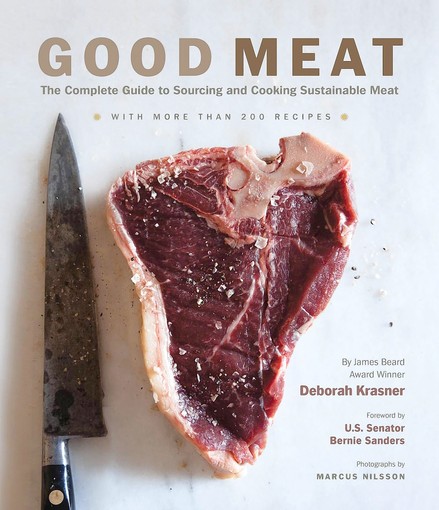Posts Tagged ‘cookbook’
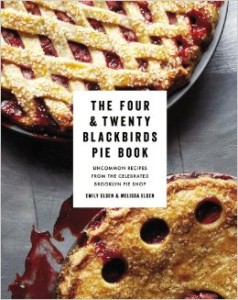 Starting last summer, I set a few fun personal goals with a couple close friends. Among my culinary goals for 2014 is baking 20 pies. Each fully from scratch.
Starting last summer, I set a few fun personal goals with a couple close friends. Among my culinary goals for 2014 is baking 20 pies. Each fully from scratch.
The inspiration came from my mother’s Christmas present of  The Four & Twenty Blackbirds Pie Book. This book had made it onto my Amazon wish list through lunch time reading of some top cookbooks of 2013 list.  At the start of 2014 I had made exactly zero pie crusts from scratch and the idea of trying intrigued me. Once I paged through the book I was hooked. Drawn in by the mouth watering photographs, I knew I had to figure out how to take on this task.The number 20 seemed like a great balance between sufficient practice and achievability.
Since I received the book in the mail about five weeks ago, I’ve made it through four pies: a butter milk chess pie, a pear anise pie, a juniper pear pie, and a lemon chess pie. My first attempt on the buttermilk chess succeed in having a fully formed crust and filling in the shape of a pie. My problem with the maiden voyage was various errors in rolling out the crust (many surrounding too little flour) cause me to over work the dough which resulted in a hard not flaky crust. But with each attempt I’ve learned more (e.g. let the dough rest in the fridge–cold dough is much easier to work) and gotten better results.
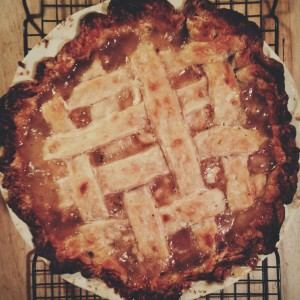
As a cookbook, The Four & Twenty Blackbirds Pie Book is a decent stand alone starting source for a pie newbie with 20+ illustrated pages dedicated to technique. The book advises against machine working the ingredients. I was fine avoiding the cost of finally biting the bullet of buying a food processor. Rather, a small investment in a simple hand held pasty blender did just fine. Other than that, I found no other special tools necessary. Just some simple ingredients and I was off baking. [I’m still rolling around the best way to represent the actual pie recipes here.]
And I’m still hooked. I’m able to achieve tasty results (lets face it, even with a mediocre pie crust like my first, a pie is still a pie) but I see room from improvement on each baking (let’s make it look more like the picture, form a more prefect lattice, keep the edge of the crust from browning too much, etc.). And, still paging through the book, I’m dreaming of spring at the farmer’s market and new fresh ingredients.
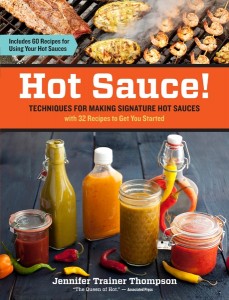 One of my latest cookbook purchases is an ode to hot sauce making: Hot Sauce!
One of my latest cookbook purchases is an ode to hot sauce making: Hot Sauce!
My attention first fell to the recipe for pili pili. Â Literally meaning “pepper” in Swahili, pili pili is an African hot sauce that deals out a solid burn without forgoing flavor. Â Unfortunately, this stuff is impossible to find here in the States. Â Luckily, Fayaz has a few hook-ups in his native land of Tanzania to supply himself and a few friends.
In making the recipe, I used five jalapeños and one habanero.  The fresh flavor of the hot sauce was fantastic blend of sweet and spice.  I can see this stuff being great with everything.  On mac & cheese, burgers, pizza…  Yum. Though, on the next go, I may need to up the habaneros to give a little more heat.
.
.
Ingredients:
- 2 cup of loosely packed fresh jalapeños or habaneros (about 6 or either), stemmed
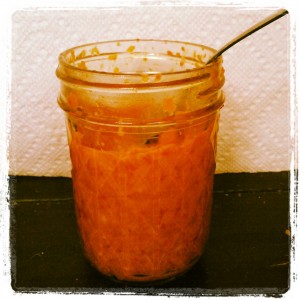
- 1 small yellow onion, peeled and quartered
- 1/4 cup fresh squeezed lemon juice
- 1/4 cup of olive oil
- 1 teaspoon chopped garlic
- 1 teaspoon ground ginger
- 1 teaspoon salt
Directions:
Add all of the ingredients to a food processor or blender and purée.  Transfer the mixture to a skillet and cook over medium heat for a few minutes.
Let cool a bit, then pour into glass bottles and seal. Â Refrigerated, the sauce will keep for 2 weeks.
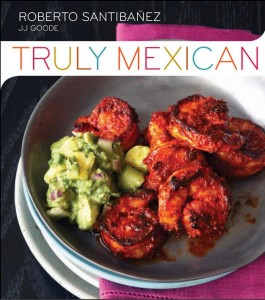 Last year, Loren posted about gifting Good Meat to his brother.  After receiving the book, Loren’s brother sat down to give it Saturday read with a few cups of tea.  I had the much the same experience when I got my hands on Truly Mexican.
Last year, Loren posted about gifting Good Meat to his brother.  After receiving the book, Loren’s brother sat down to give it Saturday read with a few cups of tea.  I had the much the same experience when I got my hands on Truly Mexican.
The author Roberto Santibanez is the head chef of Fonda (the restaurant that redefined Mexican food for me).  Before I’d eaten at Fonda, I heard Santibanez on The Splendid Table and knew I had to learn more about real Mexican food.  My meals at Fonda have blown me away and I could only resist buying this book for so long.
The cookbook offers up page after page of instruction, recipes, and beautiful photos.  The reader is taken through the basics (how do you core a tomato, roast garlic, or pit an avocado) through easily executed salsas, guacamoles, and adobos to the advanced 22 ingredient multi-hour process that is the legendary mole poblano.
Another thing I love about this cookbook is the fact that Santibanez recognizes that owning the book doesn’t mean that you automatically live in Mexico or give you access to markets filled with the proper ingredients. To help bridge the gap between grocery store reality and Mexican cooking necessity, Truly Mexican lists a number of websites where more obscure chilies and other ingredients can be purchased and offers a few alternative chili peppers for some of the dishes.  I know it would be great to make my way to a proper store to purchase these items, but it’s nice to know I don’t have to to get what I need.
I haven’t gotten to cooking anything from here yet, but, once I’ve take care of Thanksgiving leftovers, Taco Tuesday better look out!  For now, I’m happy to page through this tasty tome before bed.
Friends, if you have ever listened to anything I said, listen closely to these words: go buy Good Meat. Do it right now, and buy me an appropriately priced gift of thanks at a later date. I bought this book for my brother and his wife for Christmas, and was pretty excited about giving it to them. Then I saw his facebook status later that week and it was something to the effect of “Spent my entire day drinking tea and reading my new cookbook”. Now, I’m a fan of cookbooks, but I have never been so grossly enthralled in one so as to give up a whole day in my weekend in order to read through it. But that is partly because this is not just a bunch of recipes sent to a bindery. It’s a holy tome of carnivorous cuisine! Each section (beef, pork, poultry, lamb, rabbit, etc.) contains a sub-section about the meat itself. You’ll find information such as discussions of the difference between grass and corn fed beef, sustainable models of protein farming, breaking down a side of beef into primal, sub-primal and butcher cuts, and suggested vendors you can order from. It’s truly, truly amazing stuff.
The following recipe is the best one I’ve had from the book so far, but that isn’t saying much since we only tried 3 recipes while down in Kansas (where my brother Allen, recipient of the book, lives) and I haven’t yet bought my own copy of Good Meat. I will say up-front, I am not a mustard guy. Especially the bolder, spicier mustards; I hate them in the same way I hate horseradish. This recipe opened my eyes. You will need
- 2 1/2 lb new potatoes, cut into 2 inch chunks (any small potatoes will work)
- 1 chicken, 5 lb
- 1 head garlic, seperated into cloves and skinned
- 1 bunch/package  rosemary
- 1 cup coarse/stone ground mustard
- 1/4 cup EVOO
- 2 tbsp soy sauce
- 1/2 cup white wine
- 2 tbsp heavy cream (pretty sure we left this part out, and it was still friggin awesome)
Heat the oven to 450. Choose a roasting pan that will hold the potatoes tightly together. The idea is to keep them from burning here. Remove excess fat from the chicken and place chunks among potatoes.
Strip the rosemary leaves from the stems, and rough chop them. Take 1/4 cup of the rosemary and set it aside. Now take half of the remaining rosemary and sprinkle it inside the bird cavity, along with some salt and pepper. The rest of the rosemary should be scattered among the tatoes in the pan.
In a bowl or blender, mix together the 1/4 cup of rosemary you reserved, the mustard, olive oil and soy sauce until its a homogenous paste. Spread that over the bird. It’s supposed to be a nice, thick crust so don’t be shy with the mustard paste. GET IT ON THERE! Place the bird on top of the potatoes, and put the roasting pan in the oven. Bake for 30 minutes, then reduce the heat to 350. You need that initial high temperature period to really set the crust and get some browning action on the outside. Let it go at 350 degrees for another 60-75 minutes until a thermometer reads 165 in the thickest part of the thigh. When its done, let it rest 15 minutes before carving the bird.
Last step: drain the juices from the roasting pan and add to a saute pan along with the wine, place over medium heat. Allow that to reduce to about 1/2 volume. Remove from the heat and stir in the cream (again, we left that part out) then you can either serve in a gravy boat or just pour it over the potatoes as a dressing.
